Among the many environmental threats facing
Laguna de Apoyo Nature Reserve, crowding by humans is more than ever the most important. The cities of Granada, Masaya, San Juan de Oriente, Catarina, Diria and Diriomo are all located on its edge. Developers daily push our weak government to get permits to build houses inside the reserve. Cars, electric lines, lights, piers, houses, yards, and people themselves continue to elbow away animal habitat. The thin strip of land ringing around Laguna de Apoyo which protects the lake, also connects forest habitats from Masaya Volcano National Park to Volcano Mombacho Nature Reserve, serves as a key piece of wild nature in southwestern Nicaragua, and is at terrible risk of destruction.
Nonetheless, there are still many wild animals in the reserve. Just this week, Pablo Somarriba and Elmer Nicaragua, staff members of
Estacion Biologica, observed a white-tailed deer nearby while performing bird monitoring work just a week ago. The
Pale-billed Woodpecker, a glorious bird, close relative of the possibly extinct
Ivory-billed Woodpecker, More than 220 species of birds are found in the reserve. Nicaragua's wildlife is easily observed here.
Although the most well-conserved forest is found in the southern section of the reserve, the immediate environment of
Estacion Biologica contains plenty of wildlife. For instance, a rather large
Boa constrictor was found by Spanish students taking an evening nature walk, only 3 meters from the edge of our property! Although one may be terrified of such a large animal, they are not poisonous nor are they aggressive, unless you happen to be a mouse or perhaps a chicken. We got snakes!
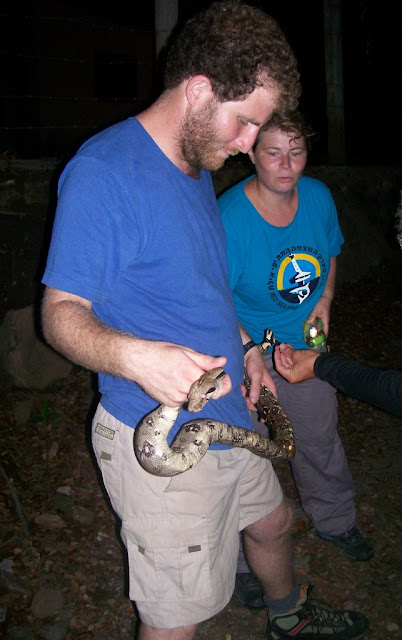 |
| Yael observes the Boa constrictor which does not visibly object to handling by Ran, making for a great wildlife photography moment. Boas are common in Laguna de Apoyo Nature Reserve, although locals kill them and any other snake on sight. Photo Jeffrey McCrary. |
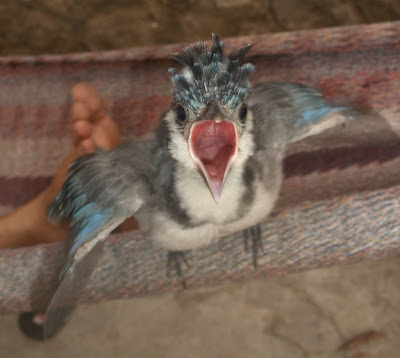 |
| This White-tailed Magpie-Jay (Calocitta formosa) chick was rescued and raised at Estacion Biologica. Photo Jeffrey McCrary. |
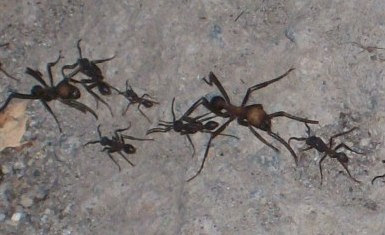 |
| Army ants (Eciton sp.) are regular visitors to Estacion Biologica, and they help us keep the house free of pests. Photo Jeffrey McCrary. |
 |
| Howler monkeys (Alouatta palliata) come into the yard often, especially to eat mangos! Photo Jeffrey McCrary. |
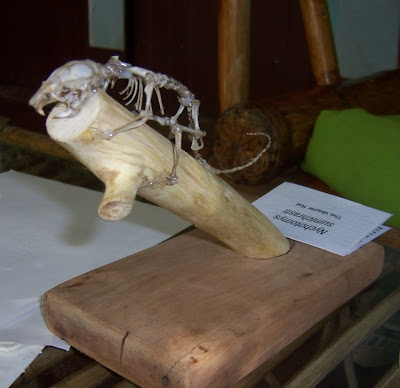 |
| This vesper rat (Nyctomys sumichrasti) skeleton was prepared by Pablo Somarriba and our volunteer Wyatt Reed. Photo Jeffrey McCrary. |
The vesper rat (
Nyctomys sumichrasti) has never before been documented to the west of the
Nicaraguan Great Lakes. Staff member Elmer Nicaragua spotted two eating the achiote (
Bixa orellana) fruit in his yard, and he handily collected them for us. Their skins were saved for DNA study while the skeleton of one of them was mounted. This finding is very important because no knowledge of the animal in this region exists to date.
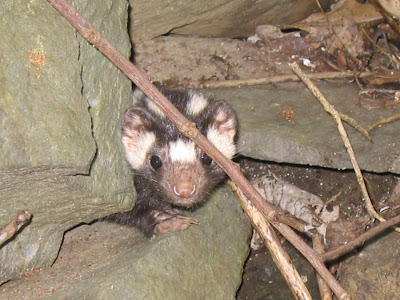 |
| Spotted skunks are common and very cute-but don't get too close! Photo Jeffrey McCrary. |
The spotted skunk (
Spilogale gracilis) is not the only skunk found in the area. It is rather easily seen at night, particularly because it can usually be tracked by smell. One can get quite close, however, without risk of being sprayed. They are often found in rocky crevices such as the one found in the above photograph, which was taken on the property of
Estacion Biologica.
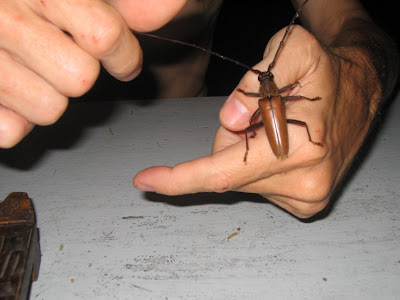 |
| Yet another fantastic beetle found in Laguna de Apoyo Nature Reserve, Nicaragua. Photo Belen Camino. |
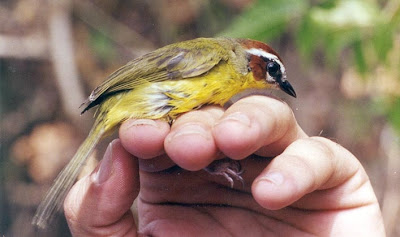 |
| The Chestnut-capped Warbler is resident in Laguna de Apoyo Nature Reserve. Photo Jeffrey McCrary. |
Most warblers found in Nicaragua are migratory, and they reproduce somewhere northward of the country. Several species of the genus Basileuterus, however, are resident, and in Laguna de Apoyo Nature Reserve, the Chestnut-capped Warbler (
Basileuterus rufifrons) is common. A pair nests almost every year on the edge of our garden at
Estacion Biologica, and during the dry season, these birds drink from our wash stand. They are easily found in midlevel forest, moving through thick foliage and on vines. The species is thought to be a species complex, with variations localized throughout its ample range.
These and more fauna are why we appreciate
Laguna de Apoyo Nature Reserve, and why we work to keep it wild. We invite your help and good will! You can help by: 1) Studying Spanish with us at
Laguna de Apoyo Spanish School. Proceeds from your classes go directly to saving wildlife and their habitats in Nicaragua; 2) volunteering to participate in our wildlife and reforestation projects; 3) donating to us-even small sums are welcome! Just US$25 dollars will fund a day of field work. We accept donations through paypal.



No comments:
Post a Comment